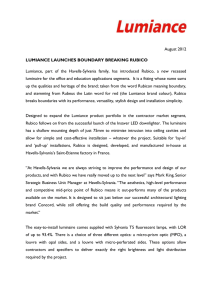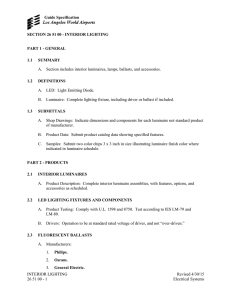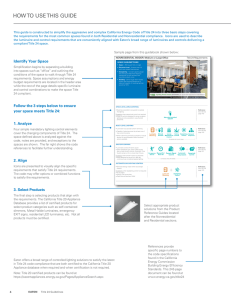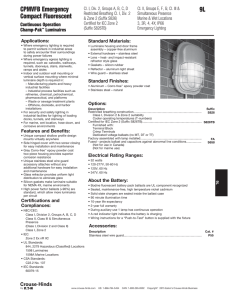Luminaire efficiency factor system for general lighting
advertisement
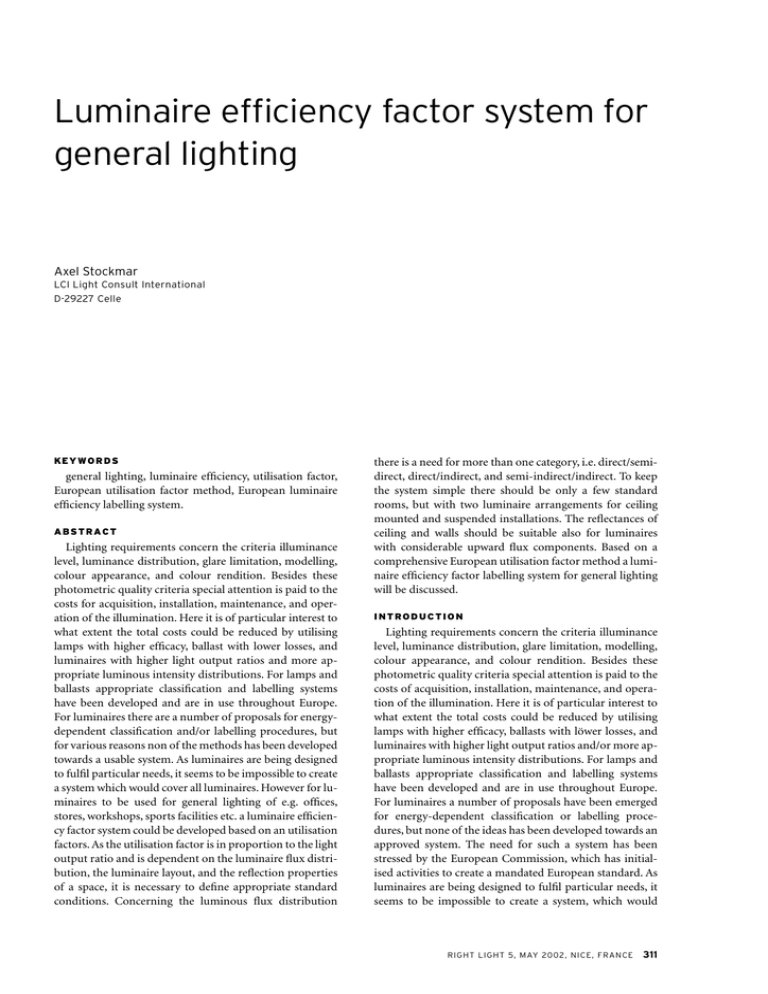
Luminaire efficiency factor system for general lighting Axel Stockmar LCI Light Consult International D-29227 Celle KEY WO R D S general lighting, luminaire efficiency, utilisation factor, European utilisation factor method, European luminaire efficiency labelling system. A B S T RA C T Lighting requirements concern the criteria illuminance level, luminance distribution, glare limitation, modelling, colour appearance, and colour rendition. Besides these photometric quality criteria special attention is paid to the costs for acquisition, installation, maintenance, and operation of the illumination. Here it is of particular interest to what extent the total costs could be reduced by utilising lamps with higher efficacy, ballast with lower losses, and luminaires with higher light output ratios and more appropriate luminous intensity distributions. For lamps and ballasts appropriate classification and labelling systems have been developed and are in use throughout Europe. For luminaires there are a number of proposals for energydependent classification and/or labelling procedures, but for various reasons non of the methods has been developed towards a usable system. As luminaires are being designed to fulfil particular needs, it seems to be impossible to create a system which would cover all luminaires. However for luminaires to be used for general lighting of e.g. offices, stores, workshops, sports facilities etc. a luminaire efficiency factor system could be developed based on an utilisation factors. As the utilisation factor is in proportion to the light output ratio and is dependent on the luminaire flux distribution, the luminaire layout, and the reflection properties of a space, it is necessary to define appropriate standard conditions. Concerning the luminous flux distribution there is a need for more than one category, i.e. direct/semidirect, direct/indirect, and semi-indirect/indirect. To keep the system simple there should be only a few standard rooms, but with two luminaire arrangements for ceiling mounted and suspended installations. The reflectances of ceiling and walls should be suitable also for luminaires with considerable upward flux components. Based on a comprehensive European utilisation factor method a luminaire efficiency factor labelling system for general lighting will be discussed. INTRODUCTION Lighting requirements concern the criteria illuminance level, luminance distribution, glare limitation, modelling, colour appearance, and colour rendition. Besides these photometric quality criteria special attention is paid to the costs of acquisition, installation, maintenance, and operation of the illumination. Here it is of particular interest to what extent the total costs could be reduced by utilising lamps with higher efficacy, ballasts with löwer losses, and luminaires with higher light output ratios and/or more appropriate luminous intensity distributions. For lamps and ballasts appropriate classification and labelling systems have been developed and are in use throughout Europe. For luminaires a number of proposals have been emerged for energy-dependent classification or labelling procedures, but none of the ideas has been developed towards an approved system. The need for such a system has been stressed by the European Commission, which has initialised activities to create a mandated European standard. As luminaires are being designed to fulfil particular needs, it seems to be impossible to create a system, which would RIGHT LIGHT 5, MAY 2002, NICE, FRANCE 311 SESSION 12: STANDARDS AND TECHNOLOGY cover all types of luminaires at the same time, such as floodlights, wall washers, and/or road lighting lanterns. However, for luminaires to be used for general lighting of e.g. offices, stores, workshops, sports facilities etc. a luminaire efficiency factor system could be developed based on utilisation factors. At the moment there are several utilisation factor methods being used in Europe showing remarkable differences. A European approach towards a luminaire efficiency factor labelling system requires as a first step a harmonised European utilisation factor method. Lamps, ballasts, and luminaires are usually regarded as independent components having different measures for energy efficiency classifications. But in many cases the combined effect of lamp, ballast, and luminaire type matter, expressed in e.g. system efficacy. If this is specified in addition, it would help to take into account incompatibilities, ambient temperature influences etc. FE A S I B I L I TY S T U D I E S A N D P R O P O S A L S The ratio of the achievable illumination level, expressed in terms of an average illuminance on a reference surface (usually the utilisation plane), to the necessary electric power depends on the selected lamps, ballasts, and luminaires as well as on the reflectances of all interior surfaces. For lamps and ballasts there are appropriate measures, efficacy and ballast-lamp circuit power respectively, which serve as a basis for energy efficiency labelling systems. However, for luminaires the obvious measure, the light output ratio, is not a suitable quantity, as there exists no relationship to the achievable illumination level. In an early study [1] it was concluded that for general lighting in interiors only a system based on utilisation factors could describe photometric properties while taking into account the necessary electric energy, as the utilisation factor is in proportion to the light output ratio and is dependent on the luminaire flux distribution for given standard conditions. Furthermore it was proposed to consider at the same time the glare limitation, as for some highly effective luminaires the glare could be exceedingly high. When this study has been made public [2] it was felt that the system should be developed further to cover more than one standard room, but without glare considerations. This was regarded not simple enough for a labelling system. In a different proposal [3] the light output ratio was considered as the suitable measure to describe the energy efficiency of luminaires. In building regulations where energy efficiency is expressed in terms of luminaire lumens per circuit watt the light output ratio plays an important role, but it will not describe the lighting performance of the installation. The more recent proposal [4] for the representation of luminaire efficiency factors based on utilisation factors for three standard rooms with room indices k=1.00, k=2.00, and k=5.00 seems to be a logic step towards a luminaire efficiency labelling systems. Unfortunately the envisaged conversion of the room indices into approximate floor plan area sizes is misleading and valid only for ceiling mounted luminaires. The room index depends not only on length and width of the interior but also on the 312 RIGHT LIGHT 5, MAY 2002, NICE, FRANCE STOCKMAR mounting height of the luminaires, i.e. the distance between luminaire plane and reference plane. For a given suspension ratio SR, the ratio of suspension height to mounting plus suspension height, a room index of for example k=5,00 for a suspended luminaire arrangement corresponds with a room index of only 3.5 to 4.0 for a ceiling mounted luminaire arrangement (figure 1) in the same interior, which makes it very difficult to compare different lighting systems. In other words, the floor area leading to the same room index differs by a factor of up to two dependent on the suspension ratio (figure 2). A further problem arises from the fact that there are several utilisation factor methods being used in Europe showing considerable differences. U T I L I S A T I O N FA C TO R M E T H O D S B E I N G U S E D I N EUROPE Throughout Europe there are at the moment several methods being used for the calculation of utilisation factors In particular these are the British as described in CIBSE Technical Memoranda No 5 [5], the German as published in LiTG Publication 3.5 [6], the French as given in the French Norm NF C71-121 [7], the Nordic as part of the NB-Documentation of luminaires [8], and the CIEMethod as specified in Publications No 40 [9] and No 52 [10]. In all utilisation factor methods considered it is assumed that the interiors are empty rectangular parallelepipeds. The working plane is assumed to be materialised by a surface, which will be counted as one of the room surfaces - with reflectance of the floor cavity. All room surfaces (ceiling, walls, and working plane) reflect uniformly and according to Lambert's law. The luminaires are arranged in regular patterns in the luminaire plane at a specified distance above the working plane. The indirect component of the utilisation factors is calculated using the common flux transfer theory. Tabulated transfer factors show virtually no differences whether they have been evaluated for rooms with a square plan or with a rectangular plan (length to width equal to 1.6 to 1). Differences experienced between the different utilisation factor methods are caused by the procedures applied to the calculation of the utilization factors for direct illumination. The important influencing factors are the luminaire layout - described best by the spacing-to-height ratio and the proximity - and the way in which the direct flux onto the working plane is calculated – zonal multipliers, stripe multipliers, point-by-point calculation etc. For the standard room with room index k=2.00 the luminaire layouts used in the different utilisation factor methods are shown in figure 3. Similar differences in luminaire arrangements are found for all room indices resulting in considerable differences between the utilisation factors obtained. An example is given in figure 4 – for the proposed reflectance combination. Following the proposal for representation of lighting efficiency factors [4] but using the room index instead of the plan area size as parameter leads in consequence to different results applying the different utilisation factor methods (figure 5). The discrepancies are larger for smaller room indices, but also smaller STOCKMAR discrepancies for larger room indices could have quite some commercial impact. RE Q U I R E M E N T S FO R A L U M I N A I R E EF F I C I E N C Y FA C TO R L A B E L L I N G SYS TE M Utilisation factors for a set of standard rooms seem to be an adequate measure to form the basis for a luminaire efficiency factor labelling system. From the presented results it is obvious that there is still a need for a common European utilisation factor method. A harmonised method should reflect as far as possible current practice. Comparisons have shown that utilisation factors calculated according to the CIE method are somewhere in the middle of the bandwidth of the utilisation factors obtained using the other methods (figure 4) [11]. Therefore a European utilisation factor method should apply the CIE method for the calculation of the utilisation factors for direct illumination. To take advantage of more pronounced luminous intensity distributions the method should allow for luminaire arrangements with different spacing-to-height ratios, preferably between 1.00 and 2.00 in steps of 0.25. For the luminaire efficiency factor system it is proposed to fix the spacing-to-height ratio at 1.00, otherwise it has to be stated every time. In addition to ceiling mounted systems the method should be extended to enable the calculation of utilisation factors for suspended arrangements. This would make it possible to compare different systems regarding luminaire efficiencies. In this case a suspension ratio has to be standardised; a realistic suspension ratio would be _. The standard sets of reflectance combinations should include the one proposed for the representation of luminaire efficiency factors, i.e. 0.70 for ceiling, 0.50 for walls, and 0.20 for the floor cavity, and also a set with higher reflectances for lighting systems with considerable indirect components [12]. CO N C L U S I O N S Provided a comprehensive European utilisation factor method could be established, calculated utilisation factors for well-defined standard conditions could be used for a luminaire efficiency factor labelling systems. It seems to be necessary to distinguish between ceiling mounted and suspended luminaires to make useful comparisons possible. The borderline between ceiling mounted and suspended luminaires could be set using a downward flux fraction of 0.90. Furthermore, for indirect lighting systems with downward flux fractions smaller than 0.10 it is probably more realistic to use higher than proposed standard reflectances for ceilings and walls. In any case the mounting mode should be stated in the luminaire efficiency factor label and/or the conversion from room index to floor plan area size should reflect the standard suspension ratio. In addition it could be useful to complement the luminaire efficiency factor label with information concerning the luminaire lumens per circuit watt – here called the system efficacy – which is needed to check conformity with some building regulations as mentioned in an earlier proposal [3]. This could help to identify energy efficient luminaires, which can use only less efficient lamps or ballasts (figure SESSION 12: STANDARDS AND TECHNOLOGY 6). The only problem remaining is the fact that very efficient luminaires could cause considerable glare which will not be notified. Therefore the glare limitation has to be evaluated separately or a glare dependent modifying factor would have to be introduced. B I B L I O G RA P HY [1] Stockmar, A.Evaluation of a Luminaire Specific Index for the Description of Photometric Properties of Interior Luminaires Taking into Account the Efficient Use of Energy, Study on behalf of CELMA, 1994. [2] Stockmar, A.Proposal for a Luminaire Specific Index for the Description of Photometric Properties of Interior Luminaires Taking into Account the Efficient Use of Energy, Proceedings RIGHT LIGHT 4, Volume 2, p. 41-45, 1997. [3] Hampton, B.Conservation of Fuel and Power: Regulations for Energy Efficiency to Protect the Environment – ‘An Industry Proposal’, CIBSE National Lighting Conference Lancaster,1998. [4] CELMA Proposal for luminaire efficiency factor presentation, CEN TC 169 document N 418, 2001. [5] CIBSE Technical Memoranda 5, The calculation and use of utilisation factors, 1980. [6] LiTG Publikation 3.5, Projektierung von Beleuchtungsanlagen nach dem Wirkungsgradverfahren, 1988. [7] NF C71-121, Méthode simplifiée de prédétermination des éclairement dans les espaces clos et classification correspondante des luminaires, UTE, 1993. [8] NBDOC, A computer program for NB-documentation of luminaires, LTLI Notat 248, 1987. [9] CIE Publication No 40, Calculations for interior Lighting, Basic method, 1978. [10] CIE Publication No 52, Calculations for interior lighting, Applied method, 1982. [11]Stockmar, A.Comparison of Utilisation Factor Methods, CEN TC 169 / WG2 document N184, 2001. [12] Stockmar, A.Proposal for a European Utilisation Factor Method, Proceedings ILUMINAT 2001, paper no. 4, p. 1-4. RIGHT LIGHT 5, MAY 2002, NICE, FRANCE 313 SESSION 12: STANDARDS AND TECHNOLOGY Figure 1: Room Index Dependence for Different Suspension Ratios 314 RIGHT LIGHT 5, MAY 2002, NICE, FRANCE STOCKMAR STOCKMAR SESSION 12: STANDARDS AND TECHNOLOGY Figure 2: Floor Area for same Room Index / Different Suspension Ratios RIGHT LIGHT 5, MAY 2002, NICE, FRANCE 315 SESSION 12: STANDARDS AND TECHNOLOGY Figure 3: Different Standard Luminaire Arrangements 316 RIGHT LIGHT 5, MAY 2002, NICE, FRANCE STOCKMAR STOCKMAR SESSION 12: STANDARDS AND TECHNOLOGY Figure 4: Comparison of Utilisation Factor Methods RIGHT LIGHT 5, MAY 2002, NICE, FRANCE 317 SESSION 12: STANDARDS AND TECHNOLOGY Figure 5: Comparison of Luminaire Efficiency Factors Figure 6: Luminaire Efficiency Factors 318 RIGHT LIGHT 5, MAY 2002, NICE, FRANCE STOCKMAR


